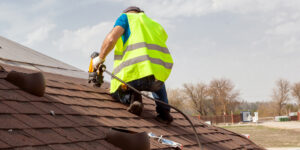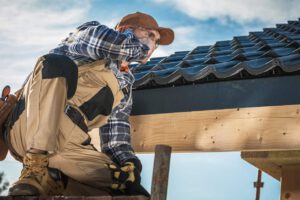Roofers are responsible for installing or repairing the roofs of residential and commercial buildings. They use various tools to complete their work, including ladders and scaffolding.

They also collaborate with other construction professionals to ensure roofing tasks are completed properly and safely. They often use customer service skills to communicate with clients and address their concerns.
Roofers install, repair, and replace the roofs of buildings using various roofing materials. Their job is important because a properly installed roof can protect structures from water leaks, which may damage the interior of a building, equipment, or furnishings.
A roofer’s responsibilities include inspecting rooftops to determine the extent of damage and what repairs are needed. They also provide clients with estimates before beginning any work. They also perform tasks such as cutting and securing roofing materials, installing flashing and vents, and ensuring that all seams are sealed and joints are watertight. They may also install insulation systems and vapor barriers.
Roofing is a dangerous job, and roofers are at risk of falling or becoming seriously injured. For this reason, it’s imperative that they follow all workplace safety guidelines at all times. They also need to wear proper clothing, use protective gear, and be aware of weather conditions when they’re on a jobsite.
In addition to the physical demands of the job, roofers are often required to travel between jobs, which can take time away from their family. For this reason, they prefer to work in a local area with a short commute or close proximity to their home.
A standard workday allows roofers to spend most of their day on the roof, where they’ll be using tools for about 80% of their time. During the remaining 20% of their time, they’ll attend meetings or participate in training. For example, at Curt’s company, employees begin each day with a five-minute safety talk and attend monthly meetings with salespeople and management. They may also help fellow roofers or answer customer questions.
They Stay Fit and Healthy
A roofer’s job involves climbing and working with heavy materials and tools. It also requires a great deal of bending and stretching. This type of work is challenging on the body and can lead to injuries if the right precautions are not taken. Here are some tips for staying fit and healthy as a roofer:
Begin each day with a warm-up. This should include a light cardio exercise or lifting weights for about 15 minutes to get the blood moving and joints lubricated. A short run is also a good option for a warm-up.
Take care when climbing and using ladders. Proper positioning of the ladder and securing it with sandbags helps to ensure that it stays stable. The use of a harness is also important to prevent falls. A fall from a roof is one of the leading causes of death in the construction industry, so it’s important to follow all safety precautions.
Wear proper personal protective equipment (PPE) such as a hard hat and safety goggles. Inspect the PPE on a daily basis and make sure that it is in good condition.
Take breaks to cool down and hydrate. Being out in the sun all day can be harmful to the skin. Drinking plenty of water and wearing a hat with a wide brim are helpful in preventing dehydration. Wearing clothing made from breathable fabrics that wick moisture away from the skin is also helpful.
Practice bending exercises to build and tone the muscles of the back. This will help to prevent back pain and injury when bending on the roof. Regularly completing forward bends and backbends will also improve flexibility.
Perform strength training workouts to build muscle and endurance. Lifting is a common part of a roofer’s job and is an effective way to stay in shape. It also helps to strengthen the core and lower back. Lifting workouts can also improve bone density and reduce the risk of fractures or shattered bones as you age.
Avoid breathing construction dusts like silica, which can cause lung or nasal cancer, silicosis, and serious respiratory problems like chronic obstructive pulmonary disease (COPD). Inhaling these dangerous particles can also cause damage to the heart and lungs.
They Have a Relaxed Workday Most of the Time
Roofers may get frustrated with their clients from time to time, but they’ll often find that working as a roofer isn’t an extremely stressful career. While it can be tough on the body, it’s also a very relaxing and rewarding job for those who enjoy working outdoors. Those who are looking for a great work-life balance should consider becoming a roofer.
While roofers may be able to get away with a relaxed workday most of the time, there are some things that can make it hard for them to relax and unwind after work. For one thing, they spend a lot of time in awkward kneeling postures which can lead to serious back problems in the future.
In addition, roofers also have to deal with the effects of heat stress and dehydration while working on a hot roof. The shingles, underlayment, and other materials on the roof can absorb and radiate a significant amount of heat, making it feel much hotter than the temperature outside. In fact, hard-working roofers can sweat out more than a quart and a half of water during an hour of moderate work. Dehydration can exacerbate hypothermia, frostbite, and other conditions that could put a crew in danger on the roof.
As a result, it’s very important for roofers to drink plenty of fluids throughout the day. They should also avoid caffeinated drinks and foods that can make the problem worse.
Finally, roofers have to be aware of the effect of sun patterns on their work. Rising and setting suns can cause the surface of a roof to get very hot, so it’s important for roofers to plan their work around this.
In addition, roofers must constantly climb up and down to fasten harnesses or install safety equipment, which can disrupt the flow of their work. This can be frustrating for some roofers, but it’s necessary for their safety and the safety of others on the jobsite.
They See the Results of Their Labor Every Day
Roofers work on homes and buildings that require a sturdy, waterproof roof to protect the structure from weather elements. They install roofing materials and ensure that the roof is stable, waterproof, and properly insulated. Without roofers, buildings would be vulnerable to leaks, structural damage, and compromised energy efficiency.
Whether it’s installing new roofing systems or repairing existing ones, roofers use a wide variety of tools to complete their tasks. Typical tools include shovels, pry bars, hammers, ladders, drills, tape measures, framing squares, and roof rakes. They also need to follow all safety guidelines when working at heights, including wearing personal protective equipment (PPE) such as helmets and harnesses, and using a fall arrest system when on the job site.
When it comes to choosing a career, roofers are typically either born with the necessary physical and mental skills or can quickly learn the trade. While some roofers have formal education or apprenticeships, others learn on the job under experienced contractors. They can choose to pursue certifications and training to improve their skill set and become a more qualified and competitive roofing contractor.
Although roofers can be a very lucrative trade, it is not without its risks. Among construction workers, roofers are over fifteen times more likely to die in a job-related accident than commercial truck drivers or steel mill employees.
In addition to the risk of falling, roofers face the potential for traumatic brain injury (TBI), severe burns, and electrocution. TBI can result from a blow to the head or body, while burning incidents are common due to heat and flammable materials. Electrocution is a major concern for roofers, as working at heights puts them in close proximity to power lines that could get energized with a sudden touch.
To minimize the risks of their profession, many roofers prioritize safety and adhere to all safety regulations. They often take extra precautions such as putting down drop cloths or tarps, and wear gloves when handling hot tar and other hazardous materials. They also encourage their crew members to wear hats, long pants, and sunscreen to shield themselves from the sun and drink water or sports drinks throughout the day to stay hydrated.

